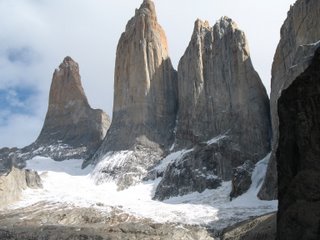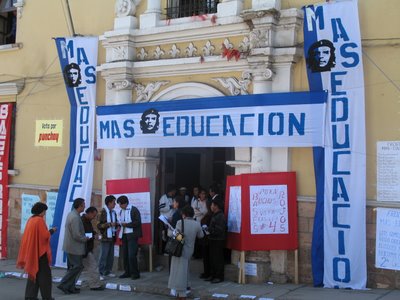Trekking Amongst the Worlds Highest Tropical Mountains

Lima was nothing to write home about, the city was shrouded in the coastal fog which plagues it for eight months of the year and I found it a drab and depressing place. A scenic bus ride north took me to Huaraz where I organised a three day trek into the Cordillera Blanca. I was joined by two Canadians, Jordan and Rene, a guide and two mules to carry the bulk of the equipment. A four hour bus ride took us into the mountains and it was a pleasant afternoon walk to reach the first camp at 3800m. We crossed the 4750m Punta Union pass the following day in miserable weather but by the time we reached camp on the other side of the pass the cloud had cleared somewhat, revealing a spectacular valley dwarfed by 6000m peaks. We decided there was time to make the side trip to Alpamayo base camp, enjoying views of the towering mountains between the clouds. Although the mountain itself remained hidden, there were plenty of hidden delights along the way. The sun came out on the final day, revealing Alpamayo for the first time and we continued down the valley to Santa Cruz to complete what must rank as perhaps the most beautiful trek of the entire trip.


A long overnight bus journey to Trujillo left me feeling exhausted and I spent a leisurely day watching the world cup and taking a stroll around town, organising a tour of the regions pre-Columbian monuments for the following day.

The giant adobe brick structures of the pyramids of the sun and moon were built by the Moche culture over 2000 years ago. Although heavily eroded they remain impressive - around 40-50 million mud bricks were used in the construction of each pyramid. Despite the names, there is no evidence to connect either temple to the worship of the sun or the moon. The Huaca de la Luna (pyramid of the moon) is the only one that has been extensively excavated - revealing some fantastic painted murals and the remains of adult males who appeared to have been sacrified. Its thought the sites were finally abandoned after rains caused by the El Niño phenomenon resulted in extensive flooding. Nearby, the citadel of Chan Chan was the capital of the Chimu culture which succeeded the Moche and covers almost eight square miles on the outskirts of Trujillo. Its a huge complex of 11 separate palaces, separated by tall adobe walls, some of which are decorated with clay friezes. The scale of the complex, rather than the structures themselves left the greatest impression.


That evening I went to a restaurant, planning to have a quick meal before getting the night bus north to the border. Shortly after arriving, a thief took off with my small rucksack. It was a well worked move, the thief's accomplice knocked over my large rucksack, providing the distraction, while the thief grabbed the smaller bag to my other side. In the pack was my passport, all my photo backups, most of my books and some souvenirs. This threw my plans to cross into Ecuador into disarray. The next day, the embassy informed me it would take two weeks for them to process a new passport. I was due to fly back home from Quito before the passport would be ready. I decided to try and cross the border without a passport - it seemed like the best chance of trying to salvage something from the last ten days.

Lima was nothing to write home about, the city was shrouded in the coastal fog which plagues it for eight months of the year and I found it a drab and depressing place. A scenic bus ride north took me to Huaraz where I organised a three day trek into the Cordillera Blanca. I was joined by two Canadians, Jordan and Rene, a guide and two mules to carry the bulk of the equipment. A four hour bus ride took us into the mountains and it was a pleasant afternoon walk to reach the first camp at 3800m. We crossed the 4750m Punta Union pass the following day in miserable weather but by the time we reached camp on the other side of the pass the cloud had cleared somewhat, revealing a spectacular valley dwarfed by 6000m peaks. We decided there was time to make the side trip to Alpamayo base camp, enjoying views of the towering mountains between the clouds. Although the mountain itself remained hidden, there were plenty of hidden delights along the way. The sun came out on the final day, revealing Alpamayo for the first time and we continued down the valley to Santa Cruz to complete what must rank as perhaps the most beautiful trek of the entire trip.


A long overnight bus journey to Trujillo left me feeling exhausted and I spent a leisurely day watching the world cup and taking a stroll around town, organising a tour of the regions pre-Columbian monuments for the following day.

The giant adobe brick structures of the pyramids of the sun and moon were built by the Moche culture over 2000 years ago. Although heavily eroded they remain impressive - around 40-50 million mud bricks were used in the construction of each pyramid. Despite the names, there is no evidence to connect either temple to the worship of the sun or the moon. The Huaca de la Luna (pyramid of the moon) is the only one that has been extensively excavated - revealing some fantastic painted murals and the remains of adult males who appeared to have been sacrified. Its thought the sites were finally abandoned after rains caused by the El Niño phenomenon resulted in extensive flooding. Nearby, the citadel of Chan Chan was the capital of the Chimu culture which succeeded the Moche and covers almost eight square miles on the outskirts of Trujillo. Its a huge complex of 11 separate palaces, separated by tall adobe walls, some of which are decorated with clay friezes. The scale of the complex, rather than the structures themselves left the greatest impression.


That evening I went to a restaurant, planning to have a quick meal before getting the night bus north to the border. Shortly after arriving, a thief took off with my small rucksack. It was a well worked move, the thief's accomplice knocked over my large rucksack, providing the distraction, while the thief grabbed the smaller bag to my other side. In the pack was my passport, all my photo backups, most of my books and some souvenirs. This threw my plans to cross into Ecuador into disarray. The next day, the embassy informed me it would take two weeks for them to process a new passport. I was due to fly back home from Quito before the passport would be ready. I decided to try and cross the border without a passport - it seemed like the best chance of trying to salvage something from the last ten days.








